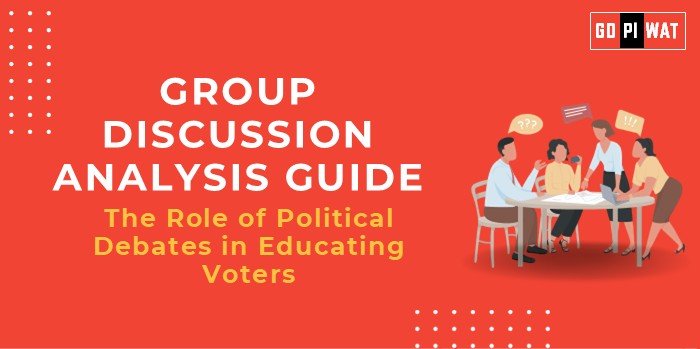📋 Group Discussion (GD) Analysis Guide
🎙️ Topic: The Role of Political Debates in Educating Voters
🌐 Introduction to the Role of Political Debates in Educating Voters
Political debates serve as platforms for candidates to present their policies, priorities, and personalities. They are critical in democratic societies, offering voters the chance to make informed decisions.
Originating from the famous 1960 Kennedy-Nixon debate, televised debates have evolved into pivotal events in modern elections globally. In India, debates are gaining importance in fostering political awareness among citizens.
📊 Quick Facts and Key Statistics
- 1960: First televised debate between John F. Kennedy and Richard Nixon reached 70 million viewers, revolutionizing political campaigns.
- 90%: Voters in a U.S. study reported debates influenced their understanding of candidate policies.
- Internet Users: Over 900 million in India (2024), highlighting the potential for online political debates to reach vast audiences.
- Digital Debates: 60% of Indian youth access political content online, showcasing the shift to digital platforms.
👥 Stakeholders and Their Roles
- Political Parties and Candidates: Communicate policies and values directly to voters.
- Media Outlets: Act as moderators and amplifiers of debates.
- Voters: Use debates to assess candidates’ abilities and priorities.
- Civil Society Organizations: Encourage informed and inclusive political discourse.
- Tech Companies: Enable digital debates, expanding reach and interactivity.
🏆 Achievements and Challenges
✔️ Achievements:
- Enhanced Awareness: Debates educate voters about diverse issues, from economics to social justice.
- Increased Engagement: Social media facilitates real-time voter interaction during debates.
- Transparency: Candidates’ positions and inconsistencies become evident under scrutiny.
⚠️ Challenges:
- Bias in Moderation: Media or moderators may skew narratives.
- Access Inequalities: Rural areas with limited connectivity miss out on digital debates.
- Fact-Checking Issues: Spread of misinformation during or after debates.
🌍 Global Comparisons:
- In the U.S., Presidential debates set benchmarks.
- France: Adopted interactive debate formats for inclusivity.
📖 Case Studies:
- India: The 2014 General Elections saw increased online engagement, but the absence of structured debates hindered deeper issue exploration.
📑 Structured Arguments for Discussion
- Supporting Stance: “Political debates promote transparency and empower voters with critical information.”
- Opposing Stance: “Bias in media moderation and unequal access diminish debates’ value.”
- Balanced Perspective: “While debates educate voters, their impact is limited by challenges in reach and fairness.”
🎯 Effective Discussion Approaches
- Opening Approaches:
- “In an era where 70% of voters consume news digitally, debates are vital for informed decision-making.”
- “The absence of structured debates in India presents both a challenge and an opportunity for democracy.”
- Counter-Argument Handling:
- Highlight global successes in enhancing debate formats.
- Propose solutions like unbiased moderation panels or hybrid formats for inclusivity.
🔍 Strategic Analysis of Strengths and Weaknesses
- Strengths: Transparency, voter engagement, platform for policy debate.
- Weaknesses: Access gaps, misinformation risks.
- Opportunities: Digital platforms, interactive debates, inclusive formats.
- Threats: Media bias, cyberattacks.
🎓 Connecting with B-School Applications
- Real-World Applications: Suitable for courses on governance, policy-making, and communication strategies.
- Sample Interview Questions:
- “How can political debates be made more accessible in rural India?”
- “Evaluate the role of social media in shaping political debates.”
- Insights for Students: Explore frameworks for effective political communication, leveraging data-driven solutions.


